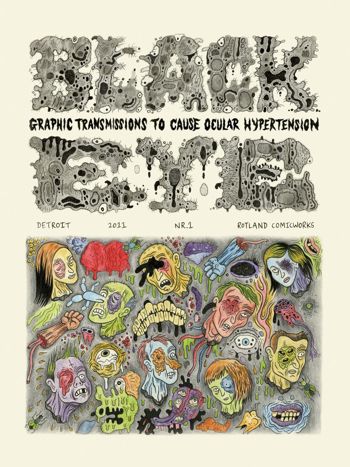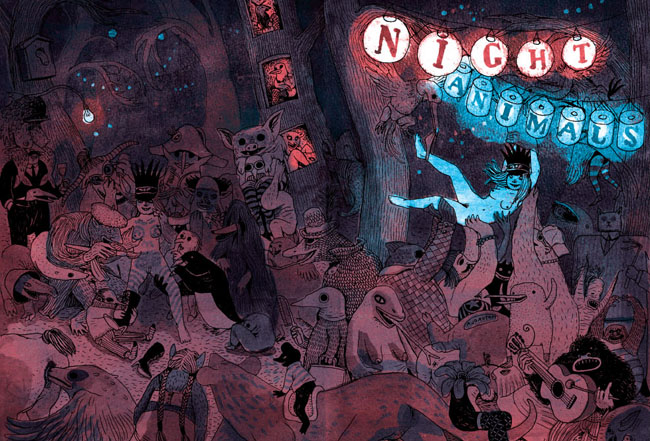Posts Tagged ‘Brecht Evens’
Comics Time: Black Eye
July 13, 2011Black Eye #1
Wouter Vanhalemeesch, Al Columbia, Ian Huebert, Mark Newgarden, Onsmith, David Paleo, Roland Topor, Olivier Deprez, Olivier Schrauwen, Brecht Evens, Ivan Brunetti, Andy Gabrysiak, Michael Kupperman, Gnot Guedin, Tom Neely, Dav Guedin, Danny Hellman, Bob Levin, Brecht Vandenbroucke, Stephen Schudlich, Martin Rowson, Kaz, Max Clotfelter, Robert Goodin, Ryan Standfest, Jon Vermilyea, Mats!?, Nikki DeSautelle, Stéphane Blanquet, R. Sikoryak, Ludovic Debeurme, Emelie Östergren, Fanny Michaëlis, Lilli Carré, James Moore, Jeet Heer, Paul Nudd, Glenn Head, Paul Hornschemeier, Ken Parille, Paul Paetzel, writers/artists
Ryan Standfest, editor
Rotland Press + Comic Works, May 2011
112 pages
$14.95
Buy it from Ryan Standfest
For today’s Comics Time review, please visit The Comics Journal.
Comics Time: Night Animals
June 24, 2011Night Animals
Brecht Evens, writer/artist
Top Shelf, January 2011
48 pages
$7.95
Read a preview and buy it from Top Shelf
Dare I say that this is even better than The Wrong Place? I think I dare! Created before that book but published in English after it, Night Animals is a more traditionally drawn affair from author Brecht Evens in that it is, in fact, drawn. The Wrong Place‘s paint-only art was its distinctive selling point and, via clever coloring, its primary storytelling mechanism, but as it turns out this innovation meant Evens abandoned a really lovely line — thick, ropy, tactile, full of motion, fun. It gives the art more immediate pop, and gives Evens’s really vibrant colors (look at that cover; now imagine a whole book like that) the day off, as it were, freeing them from the burden of telling the story themselves and allowing them to comment on and enhance the action, and of course simply delight the eye.
Said action consists of two separate stories in which the protagonists’ sexuality is passed through a gauntlet of children’s-story-style creatures of the wild. The first, in which a balding businessman and apparent tyro furry goes down a literal rabbit hole and braves an increasingly terrifying series of beasts on his way to the “Blind Date” that gives the story its title, has a happy ending: A grinning, recumbent woman in rabbit ears, probably a little plain under normal circumstances with her hornrimmed glasses and mole and pointy schnoz but bomb-ass hot as she’s presented at the end of this journey, with a promising white arrow directing her bunny-suited suitor straight to her crotch. After the painstakingly delineated labyrinth we’ve followed to get here, including a pair of stunning spreads filled with seemingly every sea monster and forest creature Evens could think of, this punchline image elicited a good-natured “haw!” from me; if I’d been there, I’d have high-fived both the guy and the girl before leaving them to get it on. Indeed, the very last image, a Wrong Place-style painted silhouette of the two characters in floppy-eared flagrante delicto, gives the impression of the artist quietly backing away and closing the door behind himself, letting our hero and heroine do their stuff in peace. Evens really nails the simple satisfaction sex sometimes provides — life can be filled with storm and stress, but every now and then it’s nothing that a special someone’s smile and genitals can’t fix.
The scarred side of the Night Animals coin is the second and concluding story, “Bad Friends.” (“So it’s not just a clever name.”—Wayne’s World) It starts, and indeed continues, innocuously enough, as a sort of distaff Where the Wild Things Are/Aesopian cover version of Stephen King’s Carrie, in which puberty rather than petulance is what enables our young protagonist to heed the call of the wild, and in which the rapid locker-room onset of menstruation leads not to a telekinetic killing spree but a visit from the Great God Pan, a trip on the back of a giant bird, and a rockin’ party with various critters in the woods. Our heroine whoops it up, enjoying the nakedness her newfound friends have reduced her to — complete with body-paint heart drawn around her pudenda — so much so that she doesn’t notice the darkness in their eyes as they close in to devour her. This story ends not with a clinch, but an empty bloodstained bed, worried parents, an ineffectual search of the now-empty forest, a single flower wilting on the ground. Evens’s trademark red goes from a spot-color stain on the girl’s underwear, to the alluring light of an illicit night out, to a symbol of sexual abandon, to the color of violence and death. It’s quite a performance, sexy and creepy at precisely the moments Evens wishes it to be one or the other, and a direct contrast with the earthy lightheartedness of the opening story. It’s awfully easy for sex comics to get didactic in their rah-rah positivity; Evens gives us the flipside, counting on us to be grown up enough to weigh the pros and cons ourselves. Good for him and good for this comic. It’s a blast.
Comic of the Year of the Day/Comics Time: The Wrong Place
December 29, 2010Every day throughout the month of December, Attentiondeficitdisorderly will spotlight one of the best comics of 2010. Today’s comic is…
The Wrong Place
Brecht Evens, writer/artist
Drawn & Quarterly, October 2010
184 pages
$14.95
Buy it from Drawn & Quarterly
Buy it from Amazon.com
The brightness of Brecht Evens’s watercolor reds may well have been the only thing that helped The Wrong Place pass my traditional “if it doesn’t appeal to you at first glance, you’ve got other books to read” test. See, I’d assumed it was just one of those froofy Euro-art comics of the sort Nick Gazin describes here as “new-age bologna.” It’s just not a visual or tonal aesthetic that speaks to me. It’s also not The Wrong Place at all.
No, here’s something that is in actual fact closer to that elusive, perhaps mythical “Okay, so I like Scott Pilgrim — what else is there?” comic than to anything else: A fun, funny, sexy, insightful comic about the lives of urban twentysomethings that doesn’t pull punches about their shortcomings but also doesn’t beat you bloody with them either, told with a unique visual vocabulary that pops off the page and makes you jealous of the creator who came up with it. The two books couldn’t possibly look more different, of course — just for example, everyone remembers Bryan Lee O’Malley’s invitingly slick manga/videogame/cartoon black-and-white line, while Evens’s lush and liquid watercolors have no real lines to speak of. But O’Malley’s pop-culture grab-bag shorthand and Evens’s symphonic color-coding both serve the same purpose: Giving the reader ready-made and memorable character designs, the better to reveal character through those designs’ interactions with the environment and with one another. In Evens’s case this mostly means tracking two polar-opposite friends, legend-in-his-own-time bon vivant Robbie (he’s blue!) and dependable, well-liked but never really well-loved Gary (he’s gray!), as well as the (presumably) latest girl to spend one crazy night with Robbie, Olivia (she’s red!).
What I like best about how things play out is that Evens resists the temptation (one I thought would be irresistible) to lecture us about the shortcomings of each character’s monochromatic approach to life. Sure, Robbie’s “on” enough to make him a nice place to visit but not live, but at no point is there any indication that his life-of-the-party lifestyle is anything but fulfilling and sincerely lived; moreover he appears to genuinely care about the well-being of everyone he comes in contact with — old friends, new lovers, random people at the club, everyone. Gary’s comparative dreariness engenders empathy, not pity or disgust; I think his motives for staying in the shadow of his friend and not taking the kinds of chances Robbie takes are clear and sympathetically portrayed — that lifestyle really isn’t for everyone! — and moreover he’s a genuine and caring guy too. Olivia decides to take a chance, and as a reward has an awesome night and reality-warping sex with a super-hot and funny and interesting dude; there’s a tinge of regret in a thoughtfully colored scene after the fact, but as best I can tell it goes unheard by Robbie and presumably the two of them, being grown-ups, wake up the next morning and go on with their lives, their experience together having enriched it just that much.
I’m glad no one has an arc to speak of. Why should they? It’s just a cartoonist painting the living shit out of parties and club nights and sex scenes and subway rides, the stuff people’s lives are made of, and sometimes those lives don’t have arcs.



